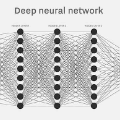Electroencephalogram (EEG) is a very promising and widely implemented procedure to study brain signals and activities by amplifying and measuring the post-synaptical potential arising from electrical impulses produced by neurons and detected by specialized electrodes attached to specific points in the scalp. It can be studied for detecting brain abnormalities, headaches, and other conditions. However, there are limited studies performed to establish a smart decision-making model to identify EEG's relation with the mood of the subject. In this experiment, EEG signals of 28 healthy human subjects have been observed with consent and attempts have been made to study and recognise moods. Savitzky-Golay band-pass filtering and Independent Component Analysis have been used for data filtration.Different neural network algorithms have been implemented to analyze and classify the EEG data based on the mood of the subject. The model is further optimised by the usage of Blackman window-based Fourier Transformation and extracting the most significant frequencies for each electrode. Using these techniques, up to 96.01% detection accuracy has been obtained.
翻译:电子脑电图(EEG)是一种非常有前途且得到广泛应用的方法,通过放大和测量来源于神经元产生且被特定电极附着在头皮特定位置上检测到的电脉冲的突触后电位来研究脑信号和活动。它可以研究检测大脑异常,头痛和其他疾病。然而,目前有限的研究旨在建立一个智能决策模型,以识别EEG与受试者情绪的关系。本实验观察了28名健康人类受试者的EEG信号,并尝试研究和识别情绪。使用Savitzky-Golay带通滤波和独立分量分析进行数据过滤。实施了不同的神经网络算法来分析和分类基于受试者情绪的EEG数据。通过使用基于Blackman窗口的傅里叶转换和提取每个电极最显着的频率优化模型。使用这些技术,达到了高达96.01%的检测准确率。



